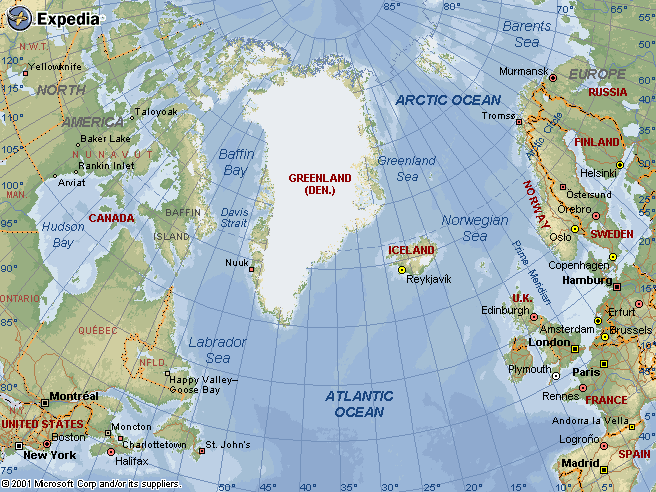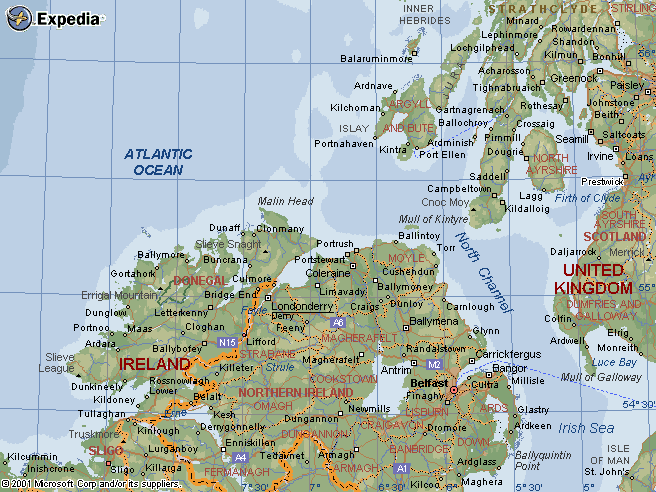
Crossing the Atlantic - the Hard Way
December, 1943
Parramore, Steichen, and three other crewmen almost didn't make it to the war. They almost had to bail out over the North Atlantic. At night. In December. Instead, they made it to the RAF base in Enniskillen, Northern Ireland, about 150 miles southwest of their intended destination - Prestwick airport near Glasgow, Scotland.

The crew made their trans-Atlantic departure from the Goose Bay airfield in Labrador the first week of December. They stayed there two or three days, and when walking between the quonset huts on the base, snow was piled "over your head." No winter clothes had been issued by the thoughtful USAAF. Parramore was from Sumter, SC, and had never seen snow before. "And here he is, up to his eyeballs in snow. You stepped off (into the snow) and you disappeared. He had every damn stitch of clothes that he owned on and he was still freezing his butt," recalls Steichen.This is where Garcia joined the crew, replacing the original bombardier, Blencoe. Garcia actually arrived with his pregnant wife, much to the surprise of others in the crew, since the date and place of departure for England was normally classified. The crew left Goose Bay in two groups -- Parramore, Steichen, and three of Baby's enlisted men as passengers on one ATC (Air Transport Command) B-17, while Sampson, Garcia, and the three other enlisted men rode separately on another ATC B-17.
The planes did not leave at the same time, and each flew alone across the Atlantic, roughly parallel to, but north of, Lindbergh's route of May, 1927 (just 16 1/2 years earlier!) In fact, the 92nd Bomb Group had recently initiated this B-17 ferry route for the Eighth Air Force. The B-17 prototype first flew in 1935, a scant 8 years after The Spirit of St. Louis was the state-of-the-art in monoplanes. Crossing the Atlantic in 1943 was still the work of pioneers.
The plane with Parramore and Steichen on board left Goose Bay in the pre-dawn darkness. The weather briefing had predicted a 45-50 mph wind about 50 degrees off to the intended course to Scotland. About one hour after takeoff, with the last stars fading in the morning light, Steichen went forward to talk to the navigator, and he suggested that they might want to take a 3-star fix while they still could.
"Yeah, that's a good idea", replied the navigator. Upon taking the fix, they determined that they were already about 45 miles off course. After the navigator assured Steichen that he would factor in an appropriate correction for the pilot to regain the original course, Steichen went back to the waist of the plane and napped near Parramore and the other three of Baby's crew.
After a few hours, Steichen woke up, talked with Parramore and the others for a while, then said, "I think I'll go down and check with the navigator and see how the hell we're doing."
Reaching the nose of the plane, Steichen asked, "How we doin'?"
"Oh", came the reply from the navigator, "we're right on the money."
Able to see only endless (cold) ocean and clouds, the unconvinced Steichen asked, "What kind of a correction did you put in?"
"Two degrees."
"Two degrees? TWO DEGREES?", yelled Steichen.
"Yeah, we're all right. We're right back on course."
Steichen retorted, "With a wind like that, maybe 50 or 60 miles per hour, and we're already 45 miles off course, I would have tried to get back on our regular course, using at least a 35 to 40 degree correction!"
.
"Well, I'm the navigator.""Yeah, you're the navigator, but I'm the one that's dead."
Returning to the waist, Steichen was asked by Parramore, "How we doin'?"
"We're dead."
"What are you talking about?", asked Parramore incredulously.
"We're dead. That's all there is to it."
"Shit."
"This asshole only cranked in for two degrees. We haven't got a snowball's chance in Hell of getting there", explained Steichen. He now recalls "having a very poor feeling at that time."Parramore immediately went forward to confer with the pilot, who was a veteran of some 50 missions in Africa. The pilot immediately started checking his radio compass and made some course adjustments. The plane was now over six or seven hours out of Goose Bay.
The plane eventually reached the coast of Ireland, although the pilot had no certainty of that at the time. Asked if he expected to hit Ireland, Steichen says, "I didn't expect to be hitting land at all. I expected to be swimming by then. This was 12 1/2 hours later. And a B-17 is not supposed to be flying 12 1/2 to 13 hours. They had it leaned out so it sounded like an old goat flying along there."
Just before it got dark, they had approached some small offshore islands. Off the shore of which country, they did not know. It was pitch dark shortly, and they hoped they were over land. The radio operator started radioing Mayday's, and he then heard similar distress calls from other planes out in the night skies. Other B-17's may have had similar difficulties with the strong winds, but their fate was never known to the crew of Baby. The pilot announced that they would have to bail out, since it was too dark to ditch the plane. The passengers and most of the crew were waiting near the hatches, ready to bail out, when a flare suddenly came up from somewhere out in the darkness. Their Mayday had been answered.
"Wait a minute, don't go yet!", yelled the pilot. "Maybe we have a pint or two of gas left." His passengers and crew retreated from the hatch openings. An airfield was suddenly illuminated below them, and the plane immediately circled in to a landing. The engines gave a tired cough and stopped. The Americans had landed at Enniskillen, an RAF field in County Fermanagh, Northern Ireland, about 150 miles southwest of their intended destination, Prestwick airfield.
In the morning, the surrounding mountains, unseen at night, were now visible. As Steichen remembers, "I got out the next morning and looked out and I saw this damn mountain that he had made a run around to get into that field. I thought, 'What the hell, talk about having the Lord on your side, or somebody.' " One half of Baby's crew had safely crossed the Atlantic, but just barely. What a way to start a war, before your first bombing mission.
A few days later, the plane took off for the relatively short hop to Prestwick. The other half of the crew had already reached Prestwick without major event, and had proceeded on ahead to England. The two groups would eventually join up at Podington, the home of the 92nd BG.
Enniskillen is a scant 10 miles from the border of Ireland. If the ATC B-17 had landed in neutral Ireland instead of Northern Ireland, the plane and crew would have been interned there and missed the entire war. This half of Baby's crew would live to make yet another landing close to a significant international border -- that between neutral Switzerland and Nazi Austria. But that distance would be measured in just yards, not miles!(Basic story and quotes courtesy of John Steichen)
Enniskillen, County Fermanagh, Northern Ireland, instead of Prestwick, Scotland. Just a few degrees off course! Enniskillen is about 150 miles southwest of Prestwick, and very close to the border of neutral Ireland.

Enniskillen airport
Photograph courtesy Robert Hirt
Copyright © 2001 by Ed Rathje